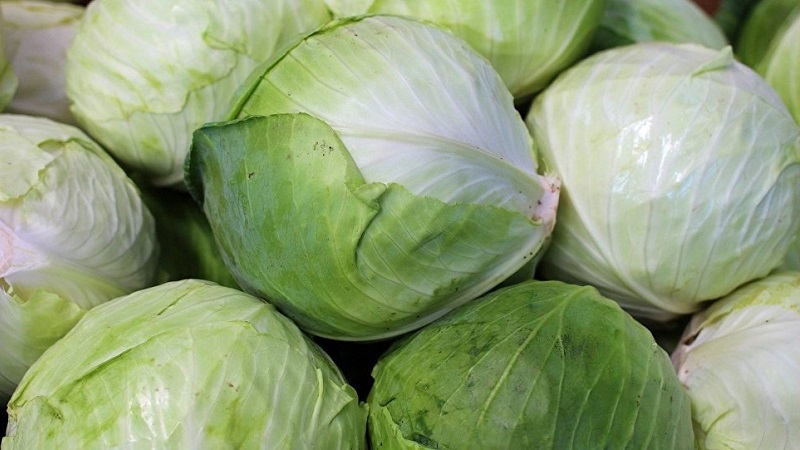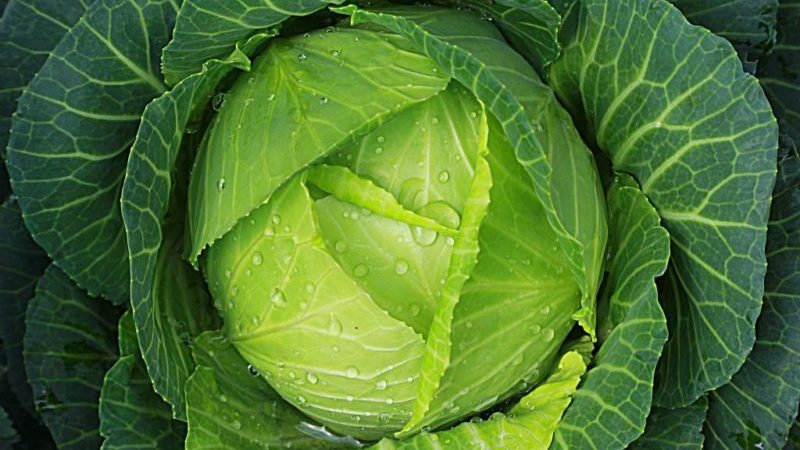A selection of the best varieties of cabbage for pickling and storage for the winter
There are hundreds of cabbage varieties, but not all are suitable for pickling, pickling and long-term storage. To make the cabbage harvest tasty, and the heads of cabbage remain fresh until spring, experts recommend carefully choosing hybrids and varieties.
You will find out which crops are ideal for long-term storage in the article.
The content of the article
Requirements for cabbage varieties for pickling and storage
When it comes to pickling and salting, then only traditional white cabbage is used for this. Colored, broccoli and red cabbage are not suitable for fermentation. They are also harvested for the winter, but according to a different recipe.
Reference! Forks that have been in the garden the longest are considered the best for pickling and pickling. In this case, the leaves of the vegetable will accumulate the maximum amount of sugars necessary for natural fermentation.
For long-term storage and salting, only mid-season and late varieties are chosen. In early cabbage, the leaves are too tender and become soft during the fermentation process.
For the plug itself, certain requirements are also put forward:
- Large heads of cabbage are preferred, as their leaves are more juicy and will crunch pleasantly after salting.
- Vegetables with green leaves are also not suitable for pickling. The forks must be white. This suggests that they contain a sufficient amount of sugars necessary for fermentation.
- Selected specimens are sure to taste. Ideally, kale should be juicy and sweet. If bitterness is present, it is better not to use such a forks for fermentation, as it will have an unpleasant aftertaste when finished.
Before shredding, check the density of the head of cabbage. To do this, he is strongly squeezed by his hands. If you hear a characteristic crunch, and juice is released from the leaves, such a fork is great for pickling. The finished snack will be crispy and juicy.

Top best varieties
Modern breeders have developed several dozen varieties and hybrids of white cabbage, designed specifically for long-term storage, fermentation and pickling. Information about each of them will help you make a choice.
Tobia F1
A hybrid of white cabbage with large forks. The weight of each of them reaches 5 kg and more.
It is considered not the most ideal option for fermentation, since the leaves lose their crunch during prolonged fermentation. Fresh, juicy and sweet, perfect for preparing first courses and salads. It is stored in the cellar for no longer than a month.
The main advantage of the hybrid is its ability to remain in the garden for a long time. If you leave the forks right on the root, they will not crack for a long time and you can assemble them when it is convenient for you.

Salting Miracle F1
One of the newer white cabbage hybrids. Bred by Dutch breeders, and the name of the hybrid speaks for itself - forks are great for pickling.
Reference! An additional advantage of the culture is its resistance to disease. In addition, while in the garden, the forks do not crack.
Cabbage is considered mid-season. Heads of cabbage are medium in size, firm. The average weight of one fork is 4 kg. The leaves contain a lot of juice and sugars, so the vegetable is ideal for fermentation.
Turkiz
One of the most famous late-ripening varieties of German-bred white cabbage.The vegetable is suitable for growing in different climatic regions, resistant to disease, cracking and drought.
The variety has the following features:
- Heads of cabbage are of the correct rounded shape, dense. The weight of one fork is no more than 3 kg, but this is fully compensated by the storage duration. In the cellar, this vegetable stays fresh until the next season.
- The upper leaves are dark green, the inside of the fork is light green, but they contain a lot of sugars. Thanks to this, Türkiz cabbage is excellent for salting and fresh consumption.
- Heads of cabbage reach technical maturity in 175 days. Cutting them off earlier is not recommended. In this case, a sufficient amount of sugars will not accumulate in the leaves, and the sauerkraut will not be tasty enough.
Aggressor F1
One of the best hybrids for growing in central Russia. Its main advantage is simplicity. Forks form perfectly on any soil, and during the growing season they do not require frequent watering or top dressing. The culture practically does not get sick, and fresh cabbage is stored for more than six months after cutting.
Heads of cabbage grow large, up to 5 kg, but at the same time they do not crack in the garden and do not wither during storage. Juice and crunch are preserved, so you can pickle or ferment the cabbage at any time.
According to the ripening period, the culture belongs to medium late hybrids. The first forks reach technical maturity 150 days after planting, but they can be cut later as they are not prone to cracking.
Kvashenka
This variety is relatively new, so few summer residents are familiar with it. But those who have already tried to ferment these forks claim that the vegetable is ideal for preparing such a preparation.
Has several features:
- Mid-season - a little more than 4 months pass from the moment of sowing the seeds to the technical maturity of the forks.
- Round forks, weighing up to 3.5 kg, with tight-fitting leaves, not susceptible to cracking.
- The variety is unpretentious, fully develops on any soil and does not suffer from sudden temperature changes.
The leaves contain a lot of sugars and ascorbic acid, so cabbage can be used not only for fermentation, but also for fresh consumption.
Polar MC
A medium late variety of cabbage for canning and processing. Heads of cabbage are round-flat, covered with light green leaves. Closer to the stump, they become white and yellow. The weight of one fork reaches 3 kg.
The ripening period is 156 days from the moment of the emergence of friendly seedlings. The dense leaves contain a lot of juice and sugars, so they remain crispy after pickling and pickling. Fresh forks can be stored for 3 to 5 months.
Megaton F1
Megaton is a medium-ripening Dutch hybrid. A distinctive feature of the heads of cabbage is their size. With proper care, the weight of one fork reaches 15 kg.
The leaves contain a lot of sugar and ascorbic acid, so the hybrid is considered one of the best for pickling and pickling. It rarely gets sick, but careful care will be needed to get a rich harvest. It consists in regular watering and feeding. Especially intensively watered cabbage during the formation and ripening of forks.
Snow White
This variety has been known for a long time, and it is in consistently high demand among summer residents.
Reference! The Snow White Cabbage is considered late, although the first forks reach technical maturity in September. Experienced gardeners recommend leaving it in the garden until the first cold snap, so that more juice and nutrients accumulate in the leaves.
The average weight of a head of cabbage is 4.5 kg. The upper leaves are pale green, the inner ones are white. It is better to grow a crop in open sunny areas and soils with neutral acidity. In the shade and on acidic soils, forks grow small and loose. Such specimens are not suitable for fermentation, although they remain fresh in a cool, dry basement for up to 8 months.
Glory 1305
The cabbage variety is considered medium late, since 125 days pass from germination to harvest. It has a high yield, and the average weight of the forks reaches 3-4 kg.
The forks reach full technical maturity in September, but if they do not start to crack, they are left in the garden to allow more juice and sugars to accumulate in the leaves.
Slava cabbage is more suitable for pickling and pickling than for fresh storage. If the cellar is too humid, the forks will start to rot after 2-3 months.
Belarusian 455
One of the oldest varieties of white cabbage. They began to grow it back in the 40s of the last century, but it has not lost its popularity among modern summer residents.
Heads of cabbage reach technical maturity in early October, but this depends on weather conditions. The minimum duration of the growing season is 105 days, and the maximum is 130. The weight of one fork reaches 3.5 kg. Outside, they are covered with dark green leaves, and inside they are completely white.
Belarusian cabbage is more suitable for canning, pickling and pickling, as its leaves remain juicy and crispy during natural fermentation. Fresh forks are stored only in cool, dry cellars with good ventilation. In such conditions, the vegetable remains until April, but it can begin to rot even with slight fluctuations in humidity.
How to choose the best early-ripening, mid-ripening, late-ripening variety for fermentation and storage
To choose the right variety of cabbage for a long storage and fermentation, you need to know the difference between early, mid-season and late crops.
Early white cabbage does not last long. She has loose heads of cabbage, and the leaves contain a lot of moisture. For this reason, forks start to rot quickly even in a cool, dry basement. It is also impossible to ferment and salt such cabbage: there are too few sugars in its leaves, so after fermentation they become soft.
Mid-season varieties are more suitable for preparing blanksthan for fresh storage. It has succulent and tight-fitting leaves with a high sugar content. Thanks to this, the sauerkraut is juicy and tasty.
Late-ripening varieties are considered universal. They have a long ripening period, so a maximum of nutrients and sugars accumulates in the leaves. The harvested crop must be sorted. Forks with loose leaves, cracks or other mechanical damage are sent for recycling. Only select medium-sized forks are placed in the cellar or basement.
Which varieties are best not to use and why
In theory, any mid-season or late variety of white cabbage is suitable for pickling and pickling. Early maturing hybrids are not suitable for this purpose due to loose heads and leaves with a high moisture content. They soften greatly during the fermentation process, do not crunch, and in some cases, the preparation even acquires an unpleasant taste.
If they plan to ferment the cabbage and not keep it fresh, it is better to choose special varieties for this purpose, for example, Belorusskaya or Slava. Their leaves contain the optimal amount of sugars for natural fermentation. As a result, the preparation is tasty, healthy and crispy.
It is interesting:
Ultra-early ripening cabbage hybrid Nozomi f1.
Conclusion
It can be concluded that only mid-season and late varieties of white cabbage are suitable for pickling and pickling. If the area of the garden allows, it is better to plant several crops at once. In the future, part of the harvest goes to salting, and special late varieties intended for fresh storage are removed to the cellar.